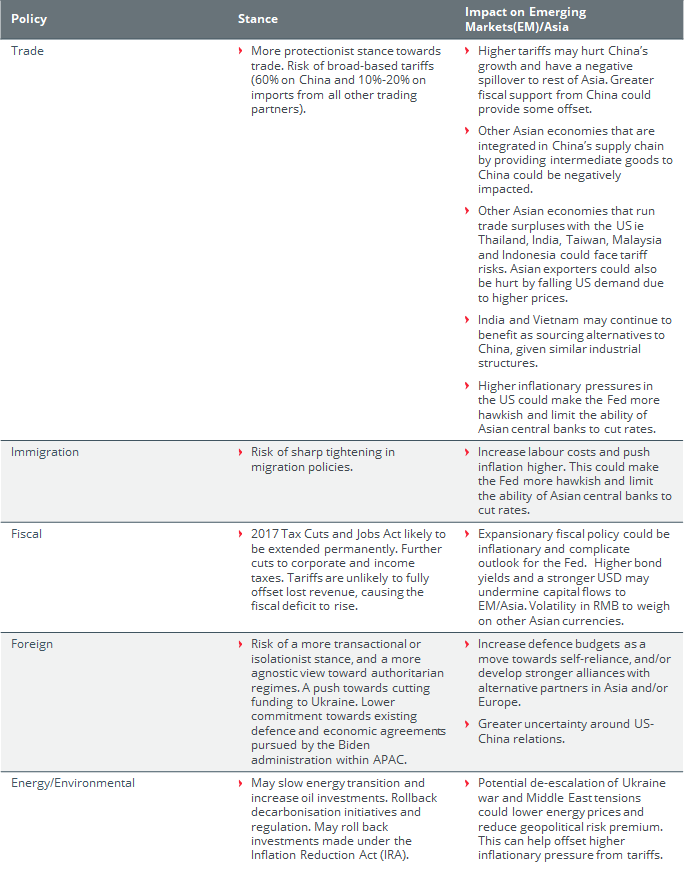Summary
A Republican sweep is expected to lead to increased tariffs, higher bond yields and a stronger USD. Against this backdrop, active security picking will be key to driving alpha in Asia and the Emerging Markets (EM) while portfolio risks must be managed more carefully in a more volatile global economic environment. ASEAN may be more defensive within Asian equities while a potential overshoot in yields could present selective bond opportunities
Trump returns to the White House as the Republicans sailed to victory, taking control of both the Senate and House of Representatives. In the weeks heading into the election, the markets have been increasingly pricing in a Republican sweep which is expected to result in larger fiscal deficits,higher inflation and tax breaks for US corporates. With a Republican sweep, the outlook for Emerging Markets (EM) will be weighed by the risks of increased trade tensions and a stronger USD. Higher tariffs and the US’ expansionary fiscal policy which are expected to be inflationary may also limit rate cuts.
According to Craig Bell, Head, Multi Asset Portfolio Solutions, a Trump-led government is expected to increase tariffs, particularly targeting China and Mexico, with other countries in the Asia ex-Japan region also being scrutinised. Beyond the immediate effects of higher prices and supply chain adjustments, investors may also want to monitor potential currency impacts, especially from a weaker RMB.
If trade protectionism rises sharply, this could increase geopolitical risks and result in a more volatile global economic environment. Against such a backdrop, Craig believes managing portfolio risks is ever more critical and investors should consider strategies that moderate drawdowns and protect against extreme left tail events. At the same time, active investing will become even more important across Asia and EMs. Countries such as India and Indonesia which have large domestic markets and positive consumption dynamics appear relatively attractive.
TARIFFS ARE A LOSE-LOSE ENDEAVOUR
Tariffs are a key part of President Trump’s campaign platform where he had proposed imposing a baseline 10%-20% tariff on all imports and 60% tariffs on goods from China.
According to o Eric Fang, Portfolio Manager, EM Fixed Income, tariffs are a lose-lose endeavour. In a scenario where there are few substitutes, exporters are less likely to lower prices. As such, the US end consumer ends up paying more. Research1 suggests that importers and end consumers in the US bore the brunt of the US-China trade war as protectionist measures also allowed domestic producers to raise prices. Separately tariffs may incur retaliatory measures which could hurt revenues of affected US exporters.
If Trump’s proposed tariffs are implemented, tariff rates may rise back to 1940 levels, potentially erasing all the earlier benefits of globalisation. The IMF warned that if higher tariffs hit a “sizeable swath” of world trade by mid-2025, it would wipe 0.8% from economic output in 2025 and 1.3% in 2026; from their initial global growth forecasts of 3.2%2.
Eric expects Trump to use the tariffs as a negotiation tool and for tariff rates to be watered down eventually. Mindful of the spikes in volatility and bond yields which followed Trump’s 2016 win, the fixed income team has been reducing duration and staying up in quality leading into the November election. They note that USD bond yields have already been rising even before the election, partially due to the resilient US economic data. The team is looking for opportunities should bond yields overshoot on the upside. With Asian bond yields at multi-year highs and the Fed still poised to cut rates moderately, high quality Asian bonds can provide attractive total returns for investors. Within EMs, the election outcome appears favourable for Turkey, Argentina, El Salvador and Israel.
For Jingjing Weng, Head of Research, Eastspring Shanghai, this new round of potential tariff hikes could have a more significant impact on the Chinese economy compared to 2018-19. Prior to the trade war, China’s GDP growth rate was 6.95% in 2017. Today, consumer confidence is weak in China, and price deflation is persistent amid a continued property downturn. In view of this, China’s 2024 GDP growth target of 5% appears ambitious.
China’s reliance on exports has also increased. In 2017, net exports contributed less than 5% to China’s headline GDP growth, compared to more than 20% in the nine months leading up to September 2024. In 2018, the RMB’s depreciation of more than 10% against the USD (from 6.2 to 6.9), helped to partly offset the tariffs’ impact. Today, the RMB is already trading at a much lower level against the USD (7.1).
There are however some mitigating factors to US tariff risks. China’s share of US imports has dropped from over 21% in 2018 to less than 14% as of August 2024. Meanwhile, for existing US imports from China, 40% are in products where China has more than 70% market share, which makes it difficult for the US to substitute3.
Since the start of the trade war with the US, China has also been diversifying its export destinations from the US and Europe to developing countries. Product upgrades, product mix improvements and increasing competitiveness have created significant export opportunities for Chinese auto, battery, construction, solar and grid equipment globally.
If tariffs on Chinese exports are raised significantly, further fiscal support and retaliatory measures from the Chinese government cannot be ruled out. At the point of writing, investors are anticipating China’s standing committee of the National People’s Congress, which is convening from Nov 4 to 8, to endorse greater fiscal support for the economy.
ASEAN COULD BE MORE DEFENSIVE
While it may be tempting to consider a Republican sweep as potentially negative for EMs and Asia, the situation is more nuanced and ultimately, earnings will be the primary driver of share prices. In such an environment, a disciplined stock picking approach is key to generating alpha.
John Tsai, Head, Growth Equities, highlights that Asian equities, as proxied by MSCI Asia Pacific ex Japan, have 10% revenue exposure to the US, led by North Asia4. ASEAN markets on the other hand are more defensive relative to the North Asian markets given their lower revenue exposure to the US, lower currency sensitivity to USD weakness and fewer direct US competitors.
Within Asia, the Technology sector is the most exposed to the US, followed by the Autos, Healthcare and Chemicals sectors. On the other hand, the Utilities, Telecoms and Financials sectors have the least US exposure.
Besides tariffs, potential US corporate tax cuts could also disadvantage 25% of Asia Pacific companies (by index weight) that compete directly with the US. That said, 11% of Asia Pacific companies have significant US-based operations which could benefit from the US tax cuts.
In a Republican sweep, fuel prices will likely be lower as more fossil fuel extraction (i.e. fracking) resumes and climate change and green policies get put on the backburner. John believes that this could help to keep Asia’s inflation under control as fuel prices make up a significant part of the region’s Consumer Price Index. However, considering that Asia is a crucial supplier of green energy solutions, electric vehicles (EV) and solar panels (China), and the EV battery supply chain (Indonesia and China) could face challenges.
DIVERSIFICATION REMAINS KEY
According to Ben Dunn, Head, and Michael Sun, Client Portfolio Manager, Quantitative Strategies, trying to time the market based on short-term dynamics—political or otherwise—is extraordinarily difficult. While elections can shape the near-term narrative, the implications for equities are more nuanced than what headlines may suggest. Investment decisions should focus on longer-term fundamentals and recognise that uncertainty can arise from many areas—not just elections.
Drawing on over two decades of data, our Quantitative Strategies team applied a political perspective to their proprietary Multi-Factor Lens to observe how each alpha factor in the Asia
Pacific ex-Japan market performed six months before and after the 2016 and 2020 US presidential elections. Under a Republican sweep in the 2016 election, Value, Low Idiosyncratic Volatility, and Quality (with a lag) factors outperformed, while Sentiment and Momentum underperformed. In contrast, in 2020, under a Democrat sweep, the Sentiment factor outperformed strongly, followed by Value, Momentum, and Low Idiosyncratic Volatility, while Quality lagged.
Diversification and resilience are key during uncertain periods. Over two decades of data affirm that a multi-factor approach with diversified alpha sources can deliver resilient and robust alpha to investors.
The key channels through which the US election outcome can impact Asia and the Emerging Markets can be seen in Fig. 1.
Fig. 1. Impact of a Republican sweep

Source: Eastspring Investments. November 2024.
Sources:
1 Amiti et al 2019, Fajgelbaum et al.,2020 and USITC 2023
2 World Economic Outlook. IMF. October 2024..
3 US elections – What’s at stake for Asian Economies. Citi Research. 31 July 2024.
4 Factset, Bloomberg, Company Data, MSCI, Goldman Sachs Global Investment Research.
The information and views expressed herein do not constitute an offer or solicitation to deal in shares of any securities or financial instruments and it is not intended for distribution or use by anyone or entity located in any jurisdiction where such distribution would be unlawful or prohibited. The information does not constitute investment advice or an offer to provide investment advisory or investment management service or the solicitation of an offer to provide investment advisory or investment management services in any jurisdiction in which an offer or solicitation would be unlawful under the securities laws of that jurisdiction.
Past performance and the predictions, projections, or forecasts on the economy, securities markets or the economic trends of the markets are not necessarily indicative of the future or likely performance of Eastspring Investments or any of the strategies managed by Eastspring Investments. An investment is subject to investment risks, including the possible loss of the principal amount invested. Where an investment is denominated in another currency, exchange rates may have an adverse effect on the value price or income of that investment. Furthermore, exposure to a single country market, specific portfolio composition or management techniques may potentially increase volatility.
Any securities mentioned are included for illustration purposes only. It should not be considered a recommendation to purchase or sell such securities. There is no assurance that any security discussed herein will remain in the portfolio at the time you receive this document or that security sold has not been repurchased.
The information provided herein is believed to be reliable at time of publication and based on matters as they exist as of the date of preparation of this report and not as of any future date. Eastspring Investments undertakes no (and disclaims any) obligation to update, modify or amend this document or to otherwise notify you in the event that any matter stated in the materials, or any opinion, projection, forecast or estimate set forth in the document, changes or subsequently becomes inaccurate. Eastspring Investments personnel may develop views and opinions that are not stated in the materials or that are contrary to the views and opinions stated in the materials at any time and from time to time as the result of a negative factor that comes to its attention in respect to an investment or for any other reason or for no reason. Eastspring Investments shall not and shall have no duty to notify you of any such views and opinions. This document is solely for information and does not have any regard to the specific investment objectives, financial or tax situation and the particular needs of any specific person who may receive this document.
Eastspring Investments Inc. (Eastspring US) primary activity is to provide certain marketing, sales servicing, and client support in the US on behalf of Eastspring Investment (Singapore) Limited (“Eastspring Singapore”). Eastspring Singapore is an affiliated investment management entity that is domiciled and registered under, among other regulatory bodies, the Monetary Authority of Singapore (MAS). Eastspring Singapore and Eastspring US are both registered with the US Securities and Exchange Commission as a registered investment adviser. Registration as an adviser does not imply a level of skill or training. Eastspring US seeks to identify and introduce to Eastspring Singapore potential institutional client prospects. Such prospects, once introduced, would contract directly with Eastspring Singapore for any investment management or advisory services. Additional information about Eastspring Singapore and Eastspring US is also is available on the SEC’s website at www.adviserinfo.sec. gov.
Certain information contained herein constitutes "forward-looking statements", which can be identified by the use of forward-looking terminology such as "may", "will", "should", "expect", "anticipate", "project", "estimate", "intend", "continue" or "believe" or the negatives thereof, other variations thereof or comparable terminology. Such information is based on expectations, estimates and projections (and assumptions underlying such information) and cannot be relied upon as a guarantee of future performance. Due to various risks and uncertainties, actual events or results, or the actual performance of any fund may differ materially from those reflected or contemplated in such forward-looking statements.
Eastspring Investments companies (excluding JV companies) are ultimately wholly-owned / indirect subsidiaries / associate of Prudential plc of the United Kingdom. Eastspring Investments companies (including JV’s) and Prudential plc are not affiliated in any manner with Prudential Financial, Inc., a company whose principal place of business is in the United States of America.














